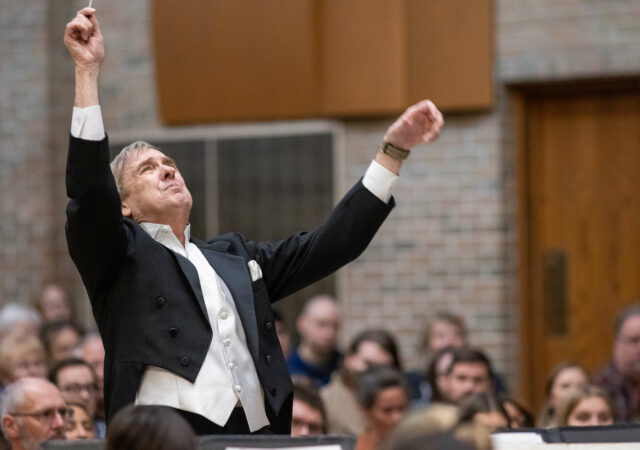
By Roger Drinnon
ST. LOUIS — In a time when so many Americans are unchurched, a dozen national mission leaders — including Synod, district and seminary representatives — met at the Synod’s International Center here April 4 to look at the future of church planting.
They gathered for a church-planting roundtable to discuss the importance of planting new LCMS churches and to examine ways to develop resources for national initiatives, as well as to have theological dialogue.
“First of all, it was the agreement on why we should plant churches – that it’s not just about our institutional preservation — it’s just a natural part of the church. It’s just who we are as a church body,” said the Rev. Steve Schave, director of LCMS Church Planting with the Office of National Mission (ONM). “We need to continue putting that in front of people to promote why church planting is important in reaching the lost.”
Given the rapid social changes in America, including the secularization of the nation in the post-modern era, Schave said Lutherans might be tempted to give up on national mission in a time when the harvest is ripe.
“The United States of America, when you look at it from a global perspective, is the third-largest population of the unchurched — China and India are the only nations on earth with more unchurched people,” he said. “In terms of how we’ve shifted so quickly both socially and demographically, there are so many new opportunities [to reach certain] ethnic groups and to reach people in rural and urban areas across the nation.”
Going where Synod has not gone
Schave said roundtable participants acknowledged the need to plant churches in places where the Synod historically has not been present.
“It’s really about finding those places where we as a church aren’t,” he said. “It’s part of what we do here in our office and working with the districts to find the locations where we need to be but aren’t. We do not have a lot of strength in the city, and we need to make it a priority, due to rapid urbanization.”
Urban, rural, multi-ethnic opportunities
Schave said opportunities for church plants abound, but the church must remain bold in reaching out to unfamiliar areas.
“We don’t want to shy away from the tough spots — we need to be in the inner cities, caring for the most marginalized, caring for the least and the broken,” he said. “I thought it was very encouraging that we did have a lot of discussion about being intentional in our efforts to reach the people that some might consider to be least like us.”
He said roundtable participants agreed deliberate outreach to urban areas and multi-ethnic communities is extremely important.
“We’re not very strong in our cities compared to how we do in rural communities,” he said. “We’re not doing well in terms of the diversity that reflects [our nation’s changing demographics]. So we need to be intentional about multi-ethnic ministry and national mission right here in our own backyard.”
Schave said that although the Synod historically has maintained a sizable presence in rural America, rural communities present opportunities and challenges similar to those found in urban America.
“A lot of what you see in urban communities — the suffering and the poverty — are hurting rural communities as well. And on top of that, there might not be an LCMS presence in a community that so badly needs it. There may be mercy work needed that can strengthen and give dignity to the poor and [provide] enterprising ways that help lift people out of poverty,” he said. “We have a lot to offer people in rural communities.”
A framework for Lutheran church planting
Roundtable members also looked at how to employ the Synod’s Witness, Mercy, Life Together initiative and the context of Martin Luther’s Marks of the Church as a framework for church planting.
“There might be lots of different models out there, but [we considered Witness, Mercy and Life Together as a framework and Luther’s Marks of the Church as a trajectory] in our national approach for those who are interested in having a daughter congregation and don’t know where to begin,” said Schave.
“It was a joy to be with others who share in our confession of the Gospel and in our passion to plant Lutheran missions. I appreciated the emphasis on Witness, Mercy and Life Together and on Luther’s seven Marks of the Church as a framework for planting Lutheran churches,” said the Rev. James Woelmer, church planter and pastor of Faith Lutheran Church in Plano, Texas, who took part in the roundtable. “A mission plant is a Lutheran church which is gathered around the Word and Sacrament. She is a light in a dark world, bringing comfort and peace in the Gospel. She also brings acts of mercy to those in the community.”
“Church planting is such an important way to reach new people with the Good News of Jesus. It was encouraging to meet with faithful leaders for a healthy dialogue about starting new churches in the LCMS,” said the Rev. Michael Newman, Texas District Missions Area C facilitator. “A variety of frameworks for church planting were expressed, but it is heartening to see that all of those approaches meet under the umbrella of the LCMS’ robust theology of outreach and solid confession of truth.”
‘Gigantic’ flock needs a shepherd
Schave said the roundtable discussions were extremely helpful as the Synod’s Mission Field: USA initiative takes root. Mission Field: USA is the flexible framework for technical support, training, equipping and organizing church planting in multiple settings and contexts.
“When you look at the United States today and all the confusion, you see this gigantic flock of the lost without a shepherd,” said Schave. “Our church-planting efforts will provide a Lutheran presence with Word and Sacrament ministry to reach the lost sheep, even into the mean streets and dark alleys. God has not abandoned the United States.”
Others participating in the roundtable were the Rev. Mark Gerken, chairman of North American Mission Endeavors, of Adel, Iowa; the Rev. Dr. Roosevelt Gray, ONM — Black Ministry, St. Louis; the Rev. Todd Jones, Concordia Seminary, St. Louis; the Rev. Mark Junkans, LINC, Houston; the Rev. John Lehenbauer, church planter for the LCMS Florida/Georgia District, Kathleen, Ga.; the Rev. Dr. Peter Meier, with the Center for U.S. Missions, Mayer, Minn.; the Rev. Geoff Robinson, LCMS Indiana District mission executive, Leo, Ind.; the Rev. Dr. Detlev Schulz of Concordia Theological Seminary, Fort Wayne, Ind.; and the Rev. Dr. Anthony Sikora, with the Confessional Lutheran Mission Society of Michigan, Dewitt, Mich.
For more information on LCMS church planting and Mission Field: USA, visit lcms.org/churchplanting.
Roger Drinnon (roger.drinnon@lcms.org) is director of Editorial Services and Media Relations for LCMS Communications.
Posted April 28, 2016





It is going to take the Holy Spirit and a cultural change in LCMS leaders and members.
If one is going to mention a cultural change in the LCMS, one also must mention a cultural change in many of those places ‘where we aren’t.’
No one can serve two (cultural) masters…
I hope not. I left the ELCA because of “cultural change”. Carl is right. Makes me think of John 15:19 and James 4:4.
How are you engaging congregations? Properly understood synod consists of thousands of local congregations. We have more assets than those found in St Louis think tanks? What are your thoughts about rooting church planting in congregations and not Synod Inc
Thanks for the words of encouragement and suggestions regarding church planting. The roundtable had an intentional cross section of congregations, districts, and synod representatives. This fits well with the overall initiative for mother congregations (or such groups) to plant churches in and with new communities, working with their districts, as the synod walks alongside to support. The discussion was held to ensure that the catalyst, tools, and resources are there for a nationwide initiative to encourage churches and congregation members to engage in church planting to establish Word and Sacrament ministries where there are none, and to reach the lost.
I have heard nothing if of this and currently serve on a district presidium that has lots of urban areas. Congregational ministry is where the front line is, how will you coalesce and set congregations of scale and resource. Congregations like the one I serve seem only important in paying convention dues.
While this initiative has been widely publicized for a few months now, the purpose of the roundtable was to help set the foundation to get it off the ground. The initiative was also recently presented to the council of district presidents to help them to share this within their districts. Each district will choose to participate differently working with their congregations. After an email was sent in February from the Office of National Mission to every congregation to encourage them to get involved (http://www.lcms.org/emailviewonwebpage.aspx?erid=10462907&trid=ca412b28-4874-4247-9b93-7af7d364757c), some congregations chose to contact their district office to participate, which is how the pilot projects came to be. Great to hear of your desire for missions in urban areas… here’s a picture of what we hope for MissionField:USA in the city, to brighten your day… https://www.facebook.com/LCMSCityMission/photos/a.1408373126082081.1073741828.1408362316083162/1677791282473596/?type=3&theater
The planting of new churches is greatly needed. However, attention and support needs to be given to failing congregations that are already there with the necessary church buildings, closed schools, and church halls. Mission work in these areas is needed to bring the gospel to the population who live in those areas.
Absolutely, this is a key component of MissionField:USA, the work of Urban & Inner City Mission, Rural & Small Town Mission, and the new revitalization program Re:Vitality.
After natural disasters and our members do volunteer work and send contributions to the synod to show mercy, Is there any evidence that those we have tried to help become members? I know we don’t help just as a way to get members but to be the hands and feet of Christ and to make his love known and show compassion but does it result in a significant increase in the number of new, practicing communicant members say 5 years after the event?
Is the act of planting new churches more doable that increasing the membership of existing churches? I’m not sure how one would answer that. I would be interested in learning about any empirical data on the subject.
We need to change our dialogue! “Church Planting” is not the goal, bringing people to Jesus should be the headline and main point of this discussion. The Denver NW Circuit of the Rocky Mountain District started a group of a few years ago under the “Gospel Gaps” initiative to look at where we could “church plant”. What we discovered was our greatest opportunity was and is where we were already.
For instance, Arvada, CO already has 3 LCMS churches but if you took the total membership of all churches in Arvada into the total population, it would be less than 30%. Part of the solution was to call a local pastor as a full time “urban missionary”. His efforts include missional communities, preaching and most of all, bringing people to Christ.
Some of our existing churches need to re-task, but have no idea how to do it. We have struggling churches in our circuit, we are reaching out to try to help them. Maybe the best solution is one presented by Pastor Dave Ahlman of Peace Lutheran, Arvada: “One”, just bring one person who doesn’t know Jesus to Him.
Indeed, the Rocky Mountain District has two pilot mission projects through MissionField: USA. LCMS Urban & Inner City Mission assists in facilitating the types of partnerships that you are discussing to support existing congregations in the urban core. And Re:Vitality seeks to help with revitalization and evangelism efforts for struggling inner city congregations as well. There are a variety of ways to support our national mission work.